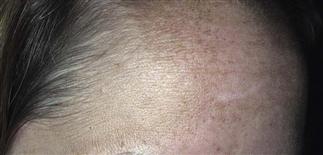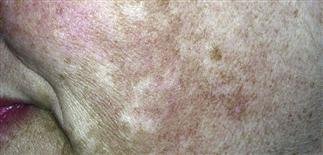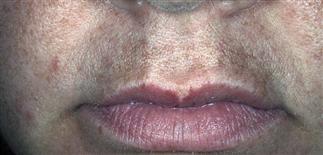114
Melasma (chloasma,
mask of pregnancy)

The upper lip and chin are the areas most frequently affected by melasma.

The pigmentation develops slowly without signs of inflammation and may be faint or dark.

Melasma occurs during the second and third trimester of pregnancy and also in some women taking oral contraceptives.

Melasma is a common complaint in women with darker skin tones.
DESCRIPTION
Acquired brown hyperpigmentation of the face and neck in genetically predisposed women.
HISTORY
• A common complaint in women of African, Hispanic, and Asian descent. Roughly 10% of cases occur in men. • The forehead, malar eminences, upper lip, and chin are most frequently affected. • Pigmentation develops slowly and is more prevalent after sunlight exposure. Prolonged heat exposure may contribute to this condition as well. • Melasma occurs during the second or third trimester of pregnancy and in some women taking oral contraceptives or other exogenous estrogens. Usually after pregnancy or with discontinuation of contraceptives, the pigment fades slowly over months to years.
PHYSICAL FINDINGS
• Symmetric macular eruption of brown hyperpigmentation. The intensity of the color varies, with deeper pigmentation in darker-skinned people. Color is usually uniform but more often blotchy and uneven. • The edges of the patches can be irregular but well defined. • No signs of inflammation.
TREATMENT
• Patients must be made aware that treatment requires several weeks and strict sun protection. Minimize sun exposure at midday and encourage wearing of hats. Sunscreens of at least SPF 30 containing avobenzone, Mexoryl, or physical blockers such as titanium dioxide or zinc oxide that block both ultraviolet A and B should be worn daily. • Combination products containing tretinoin, hydroquinone, and fluocinolone (Tri-Luma) may be more effective and more convenient. This is applied once each day for 8 weeks and may be used intermittently for up to 1 year. • Over-the-counter hydroquinone products are at 2% concentrations (Porcelana). Prescription products include 3% (Melanex) and 4% (Claripel, Lustra, Eldoquin Forte, and Solaquin Forte). Hydroquinone can be an irritant and a sensitizer. • Tretinoin is also effective as monotherapy. Tretinoin cream 0.025%, 0.05%, 0.1% (Retin-A) and tretinoin emollient cream 0.05% (Renova) enhance the effectiveness of hydroquinones. EpiQuin Micro contains 4% hydroquinone and retinol. • Azelaic acid (Finacea gel) is safe during pregnancy. • In-office superficial peels with glycolic acid or intermediate peels with trichlroeacetic acid require expertise. • May be used in combination with tretinoin and hydroquinone at home.







